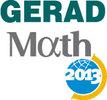HEC Montréal, Canada, 6 - 8 mai 2013
Journées de l'optimisation 2013
HEC Montréal, Canada, 6 — 8 mai 2013

MA4 Applications en génie des mines I / Applications in Mining Engineering I
6 mai 2013 10h30 – 12h10
Salle: Van Houtte
Présidée par Rafael Martinelli
4 présentations
-
 10h30 - 10h55
10h30 - 10h55An Extended Stochastic Optimization Method for Multi-Process Mining Complexes
A heuristic method is presented to generate life-of-mine production schedules accounting for geological uncertainty and considering extracting, stockpiling and processing decisions. The method improves an initial solution by swapping periods and destinations of mining blocks. Numerical tests indicate that the proposed method outperforms traditional deterministic approaches in terms of NPV.
-
 10h55 - 11h20
10h55 - 11h20Mining Supply Chain Optimization under Geological Uncertainty
Mining complexes can be modelled as a supply chain from sources of material through processing streams to a set of products. This presentation proposes a simulation-optimization framework for optimizing mining supply chains and destination policies under geological uncertainty. This method is tested at Vale’s Onça Puma nickel laterite mining complex.
-
 11h20 - 11h45
11h20 - 11h45Stochastic Network Flow Based Algorithm Applied to the Mine Production Schedule of Multi-Processor Open-Pit Mines.
We explore a new heuristic approach to solve a stochastic version of the mine production scheduling problem accounting for geological uncertainty. The methodology involves generating an initial solution by solving a series of sub-problems using either Branch-and-Cut or a greedy heuristic. Subsequently, this initial solution is improved using a network flow based algorithm.
-
 11h45 - 12h10
11h45 - 12h10A Variable Neighborhood Descent Algorithm for the Open-Pit Mine Production Scheduling Problem with Metal Uncertainty
We consider a stochastic version of the open-pit mine production scheduling problem, where the uncertainty stems from the orebody metal content. We propose a metaheuristic solution method based on variable neighborhood descent. Computational experiments indicate the efficiency of the proposed method in generating near-optimal solutions in reasonable computational times.

